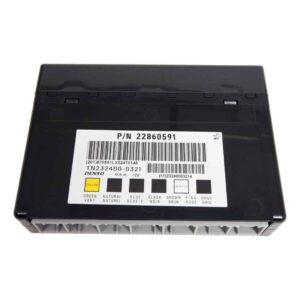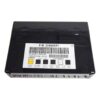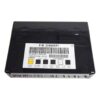If your 2010 Chevrolet Avalanche 1500 is starting to act haunted—with flickering lights, power windows with a mind of their own, or random warning messages on the dash—you’re likely dealing with a failing Body Control Module (BCM). As a technician with over two decades of experience, I’ve seen this exact scenario play out hundreds of times. The BCM is the central nervous system for your truck’s comfort and convenience features, and when it goes, it can cause a cascade of frustrating electrical gremlins.
Don’t let a faulty module sideline your truck or force you into an expensive and time-consuming visit to the dealership. We offer a reliable, straightforward solution. This is a direct-fit replacement Body Control Module, part number 25934762, that comes with our expert Cloning Service. Simply provide us with your vehicle’s VIN during checkout, and our technicians will program the module with the latest GM software specific to your Avalanche. This ensures that when the part arrives, it’s ready for installation, saving you hundreds in dealer programming fees.
From the Diagnostic Bay: The Case of the Haunted Truck
A customer brought in his 2010 Avalanche complaining that his radio would turn off, the door locks would cycle while driving, and the security light was always on. He’d already replaced the battery and checked all the fuses. On the scan tool, I found a slew of ‘U’ codes, specifically a U0140 (Lost Communication With Body Control Module). This is a classic sign. Instead of a complex wiring chase, we identified the BCM as the culprit. By installing one of our VIN-programmed modules, we had all the systems communicating correctly in under an hour. The customer drove away with his truck’s electronics fully restored, avoiding a massive diagnostic bill and a long wait at the dealership.
Is Your Avalanche Showing These Electrical Gremlins?
A failing BCM doesn’t always trigger a check engine light. Instead, watch for these common symptoms, which a replacement 2010 Avalanche 1500 Body Control Module will resolve:
- ✔ Power windows, door locks, or mirrors operating intermittently or not at all.
- ✔ Interior or exterior lights flickering, staying on, or not turning on.
- ✔ The security system acting up, causing no-start conditions.
- ✔ Horn sounding randomly or not working when pressed.
- ✔ Diagnostic trouble codes (DTCs) related to communication errors, such as U0140, U0155, or U0164.
- ✔ Inaccurate gauge readings on the instrument cluster.
Your Straightforward BCM Installation Guide
Installing your pre-programmed BCM is a manageable job for a DIYer with basic tools. While the exact location can vary slightly, on the 2010 Avalanche, you’ll typically find it under the driver’s side of the dashboard.
- Safety First: Always disconnect the negative terminal from your truck’s battery to prevent any electrical shorts.
- Locate the BCM: On the Avalanche, it’s usually mounted to a bracket under the steering column. You may need to remove a lower dash panel for access.
- Disconnect and Remove: Carefully unplug the electrical connectors. They have locking tabs that need to be depressed. Once disconnected, unbolt the module from its mounting bracket.
- Install the New Module: Mount the new, programmed BCM in the same location and securely reconnect all electrical connectors. You should hear a ‘click’ as they lock into place.
- Reconnect and Test: Reconnect the negative battery terminal. Turn the key to the ‘On’ position and test all body functions—windows, locks, lights, radio, etc.—to confirm the repair.
Post-Installation Procedures & Notes
Our cloning service handles the heavy lifting, but some GM vehicles may require a simple relearn procedure after installation. These can often be done with a high-end scan tool.
- Airbag System Sync: If you see an airbag warning light, a ‘Setup SDM Primary Key in BCM’ procedure is needed to sync the systems. This is only required if the light appears after the swap.
- Brake Pedal Position Relearn: On some models, a brake pedal position sensor relearn might be necessary for proper brake light and traction control operation.
Disclaimer: Vehicle systems vary. We always recommend consulting a factory service manual or a certified technician if you are unsure about any step.
Verified Fitment Across GM Models
This BCM is a direct replacement for part number 25934762 and is compatible with a wide range of GM vehicles. It also interchanges with the following part numbers: 10382479, 15093910, 15276271, 15299986, 15819552, 15828601, 15837419, 15872388, 15872421, 15880684, 15921352, 15921353, 15948438, 15948439, 20815898, 20839063, 20864767, 20864768, 20921435, 20921436, 20935349, 22860591, 25826124, 25826125, 25847588, 25847589, 25892622, 25910474, 25934762, 25934763, 95151084. Please verify your part number or contact us with your VIN to ensure compatibility.
Frequently Asked Questions
Frequently Asked Questions
How does the VIN programming service work?
After you place your order, simply send us your 17-digit VIN. Our technicians will use it to load the correct GM factory software onto the BCM before shipping it to you. This makes the unit ready for installation upon arrival.
Do I need to send my original BCM to you?
No, this is our Cloning Service. We program a replacement module for you based on your VIN. Your original module is always returned to you along with the programmed replacement unit. We do not keep the core.
Is this a difficult part to install myself?
For someone with basic mechanical skills, this is a very manageable job. It typically involves removing a lower dash panel and a few bolts. The main challenge is working in a tight space. Our guide above provides the key steps.
Will this fix my specific electrical problem?
This 2010 Avalanche 1500 Body Control Module is the solution for a wide range of common electrical failures. If your vehicle is exhibiting multiple symptoms from our list (erratic lights, locks, windows, communication codes), a faulty BCM is the most likely cause.
What tools are required for the post-installation procedures?
Procedures like the Airbag System Sync or Brake Pedal Position Relearn typically require a bi-directional professional diagnostic tool (like a Snap-on, Autel, or GM Tech 2) that can perform module-specific functions. Many local repair shops can perform these for a small fee if needed.



